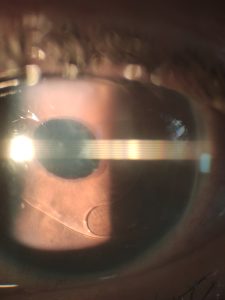"Any patient you meet in your path, in any situation, should be treated with kindness and affection, a patient is by definition a person who has a problem and your job as a doctor, even before being an ophthalmologist, is to help him or her make the right decisions for his or her health": this is a beautiful description of how the doctor-patient relationship should always be.
Dr. Giovanni Scandura describes to "I'll tell you a story..." a complex, or at least unusual, case of the management of a patient who had undergone cataract surgery many years earlier and was being treated for ocular hypertonus, but above all he speaks from the heart about how the doctor-patient relationship should be
How did you choose your training in Ophthalmology and what is your current professional profile?

The decision to become an ophthalmologist came about during my university years, following Ophthalmology lectures. I was fascinated by the amount of 'toys' the ophthalmologist uses to work and for me, who despite my classical studies has always been a science enthusiast, it was a thunderbolt. As I see it, ophthalmology has a closer relationship with exact science than other medical branches and the fact that much of what I do when I work is the product of precise obedience to certain laws has something comforting about it. Then I am naturally curious and I am also fascinated to discover the art of the venerable masters, made up of pierced mirrors, collector lenses and hammer lamps.
After completing my specialisation at the University of Catania, with a brief stay at the University of Catanzaro, I set up my own private practice and continued to frequent as a volunteer that wonderful chapter in the history of ophthalmology in Catania that was the Santa Marta hospital. I then worked for almost two years as a medical director at the 'Policlinico-San Marco' hospital and now continue to practice as a freelancer, carrying out my surgical activity at the Distefano Velona clinic at the Policlinico Morgagni.
The thing I love most about my job is the opportunity I have to improve the quality of life of the people I am privileged to care for. I will not forget one child in particular, whom I found myself visiting one morning in hospital: he had a very limited way of expressing himself and was extremely withdrawn. I found him a few months later at the check-up, transformed into a small, volcanic leader simply because, thanks to my therapeutic intervention, he had begun to see well

Can you tell us about an unusual or particularly complex clinical case that you managed to handle and solve?
I don't know whether to call it complex, but unusual it certainly was. It was the time of the first lockdown due to the Covid-19 pandemic and I was not clear whether I was allowed to continue working in the practice or not. Anyway, I am contacted by a patient who reports unspecified discomfort, I visit her and notice the presence of cellularity in the anterior chamber. The lady, a beautiful woman in her sixties, had suffered from a very early bilateral cataract and in the eye in question she had implanted an old anterior chamber IOL, one of those with part of the loop occupying the proximity of the irido-corneal angle, and had been undergoing lifelong therapy with topical timolol, which was sufficient to compensate for the tone. He told me that immediately after cataract surgery, almost thirty years ago, he had an episode of violent hypertone, which resolved after an upper iridotomy was performed (the iris had not been touched either before or during surgery).
I administered midriatic and cortisone as therapy, the eye calmed down, but the tone rose. The angle was almost completely closed between the loops of the IOL and numerous synechiae (probably the result of past hypertone), but up to that point medication had been sufficient to keep it within acceptable limits.

I suspend the therapy I had given, the tone drops, but Tyndall reappears.
After several trials to try to keep the tone low without having signs of inflammation in the anterior chamber, I realised that when the patient was free of mydriatics, the iris, pushed slightly forward (possibly because the only iridotomy performed up to that point had been occupied by the vitreous) rubbed against the plate of the IOL, causing the appearance of the inflammatory phenomenon.
Before resorting to more invasive approaches, I tried two iridotomies performed in the spaces allowed by the encumbrance of the IOL, but with poor results.
The situation resolved after an anterior vitrectomy with gonio-synechiolysis.
I pointed out that it was impossible to remove the IOL because after decades in that position, it was now an integral part of the angle and that in any case the endothelium was not in a bad state; on the contrary, the large opening that had to be made in order to extract this type of lens would certainly have led to greater problems.
Now the patient's eye, in complete tonometric compensation, is at rest, maintaining perfect visus.
A few tips for young colleagues starting out in Ophthalmology.
I have to smile because I don't think I belong to the non-young category yet, but I will try to be useful anyway, at least to those younger than me: always try to put yourself in the shoes of the person in front of you. Any patient you meet on your path, in any situation, should be treated with kindness and affection, a patient is by definition a person who has a problem and your job as doctors, even before being ophthalmologists, is to help him or her make the right decisions for their health.
A patient does not have to be cultured, he does not have to be nice, he does not have to understand what you tell him. He certainly does not stand before you for his own amusement and, therefore, does not deserve to be treated a priori with condescension, nor does he deserve for you to add your discontent to his.
On the contrary, it is you who must make him understand, you who must help him, you who must alleviate his suffering.
A wise man once told me that no matter how difficult it can sometimes be to sit behind a microscope with a patient who has decided that day he will sell his skin dearly, he will never do what you tell him. You have to try not to pour out on the patient the turmoil of emotions that is stirring within us because most probably, lying on an operating table, he is afraid and confused and we will certainly not improve the situation by shouting in anger.
I would like to take this opportunity to thank everyone from whom I have been able to learn something new, there would be too many to list, but it is thanks to each of them that I have a job I love today.
On the subject of complex post-cataract cases, on our site
Post-cataract infections in patients with type 2 diabetes - Oculista Italiano
Under the heading "I tell you a story..."
- "The more I like doing something..." - Italian ophthalmologist
Interview with Dr Silvio Zagari
- 'Give a woman the appropriate opportunities and...' - Italian Ophthalmologist
Interview with Dr Manuela D'Aquino - Open up to the world!!! - Italian Ophthalmologist
Interview with Dr Miguel Rechichi - Every clinical case: an opportunity for growth - Oculista Italiano
Interview with Dr Marco Zagari - The 'allologist' is a thing of the past - Oculista Italiano
Interview with Dr Francesco Cerbella - Broadening our views - Oculista Italiano
Interview with Dr Pasquale Napolitano - Basic skills in each subspeciality - Oculista Italiano
Interview with Dr Beatrice Tombolini
- Let your heart lead you too - Oculista Italiano
Interview with Dr Danilo Mazzacane - "Travelling a lot to learn... - Oculista Italiano
Interview with Dr Federica Fossataro - The best refractive solution for each individual patient - Oculista Italiano
Interview Dr. Antonio Randazzo
Editorial info
Our column is open to all ophthalmologists who are interested in telling their colleagues and our web audience about a clinical case.
We invite anyone wishing to participate in our publishing project to contact
Editorial Board 'l'Oculista italiano' - Ada Puglisi
Tel. +39 095 79.22.145
E-mail: info@oculistaitaliano.it
Or write to us using one of our contact forms
